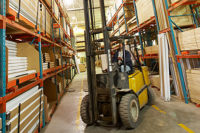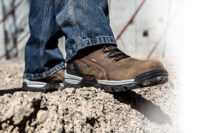Focus on your feet
By age 50, you’ve logged 75,000 miles on your “wheels”

According to the American Podiatric Medical Association, most Americans log an amazing 75,000 miles on their feet by the time they reach age 50. That’s a lot of wear and tear on the feet. And work environments can expose the feet to a wide range of added hazards.
Foot injuries include punctures, crushing, sprains, lacerations and slip-and-fall related injuries. Other foot problems that can cause discomfort, pain and fatigue include calluses, ingrown toenails or simply tired feet. Fatigue sets up the worker for further injuries affecting the muscles and joints, and a worker who is tired or in pain is more likely to act unsafely. Foot problems can affect the knees, hips and lower back as well, says the American Orthopaedic Foot & Ankle Society.
Common causes
Some common causes of foot problems include: long periods of standing, hard flooring and poorly fitted footwear.
Standing: Since the human foot is designed for mobility, maintaining an upright stance is extremely tiring. Continuous standing can cause the joints of bones of the feet to become misaligned (e.g., cause flat feet) and can cause inflammation that can lead later to rheumatism and arthritis.
Flooring: Hard, unyielding floors like concrete are the least comfortable surfaces to work on. Working on a hard floor has the impact of a hammer, pounding the heel at every step. Slippery floors are hazardous for slips and falls that can result in sprained ankles or broken foot bones.
Footwear: Footwear that fits poorly (i.e., too loose, too tight, lack of arch support) or is in need of repair also contributes heavily to foot discomfort. Pointed toes and high heels are particularly inappropriate for working footwear.
Here are some specific examples of foot injuries and common causes:
Practice prevention
The first step in developing a strategy to reduce foot problems is to identify the relevant hazards at the workplace. Such hazards should be assessed in each workplace, no matter how safe or how dangerous it may seem.
Here are some tips for job and workplace design that can help prevent foot problems and injuries:
- Design jobs to avoid fixed positions, especially fixed standing positions
- Incorporate frequent, short rest breaks if job redesign is impractical
- Use an adjustable work surface for standing jobs, or use a platform to raise the worker or a pedestal to raise the object
- Use a foot-rail or footrest to allow the worker to shift weight from one leg to the other
- If work can only be done while standing, provide a seat for resting purposes.
- Separate mobile equipment from pedestrian traffic and install safety mirrors and warning signs to help prevent accidents
- Use proper guarding of machines such as chain saws or rotary mowers
- Keep the workplace clean and organized
- Use color contrast and angular lighting to improve depth vision in areas such as stairs, ramps and passageways
- Install more resilient flooring or use anti-fatigue matting (properly installed to prevent trips and slips)
- Consider the use of anti-slip flooring or matting
Footwear
Proper footwear is important for safety and comfort. Improper footwear can cause or aggravate existing foot problems. OSHA requires the use of protective footwear when there is a danger of foot injuries due to falling or rolling objects, or objects piercing the sole, and when employees’ feet are exposed to electrical hazards.
In addition to ensuring that workers wear protective footwear when needed, the best way to involve workers in programs to protect their feet is to provide:
- training and information on the health hazards of wearing improper shoes,
- the principles for selecting proper ones, and
- the simple rules of general foot care.
Source: Canadian Centre for Occupational Health & Safety, Foot Comfort & Safety at Work, http://www.ccohs.ca/oshanswers/prevention/ppe/foot_com.html
Looking for a reprint of this article?
From high-res PDFs to custom plaques, order your copy today!





